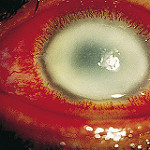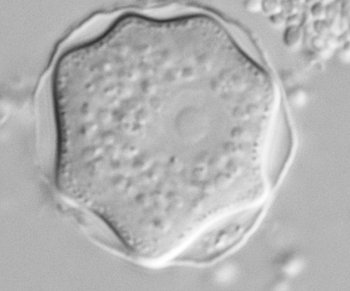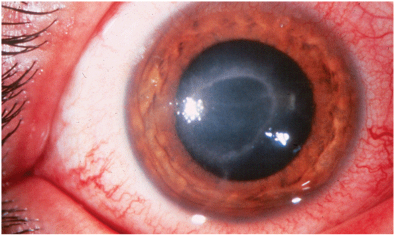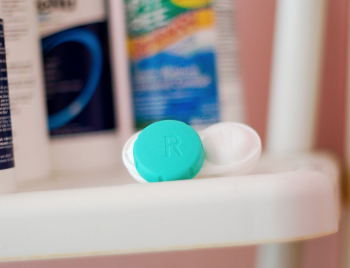Home > about eyes > Acanthamoeba Keratitis
Acanthamoeba Keratitis
Acanthamoeba Keratitis:
What is Acanthamoeba keratitis?
Acanthamoeba keratitis is an infection of the cornea, the clear “window” at the front of the eye, that can be very painful. The infection is caused by a micro-organism called Acanthamoeba. It may result in permanent visual impairment or blindness. Acanthamoeba keratitis in contact lens wearers are rare but serious, it could cause blindness if left untreated properly. It usually links to non hygiene handling of contact lenses for example wearing contact lenses to hot pools, mineral pools, unwashed hands etc. Acanthamoeba keratitis could cause scarring on the cornea, then corneal transplantation surgery might be necessary to gain vision again.

Contact lens wearers should follow lens wearing and cleaning instructions from eye care practitioners e.g optometrists. Cleaning contact lens and contact lens cases on a regular basis reduces the risk of all contact lens-related eye infections and inflammation. Contact lenses must be thoroughly disinfected before wearing, and should be removed when swimming, surfing or doing other water activities. However, there have been many cases of Acanthamoeba eye infections in those who don't wear contact lenses. Prevention is always the best approach, because Acanthamoeba keratitis can be extremely difficult to treat.
Acanthamoeba is common in nature and is usually found in bodies of water, lakes, oceans, rivers, swimming pools, hot pools, mineral pools, sewage systems, tap water, soil and air.
Acanthamoeba generally do not cause harm to humans, however they can cause serious eye disease if they infect the cornea which is usually related to contact lenses wearing. If these tiny organisms infect the eye, Acanthamoeba keratitis results. The condition was first diagnosed in 1973, with about 90 percent of cases involving contact lens wearers.
So, strict guidelines for contact lens wearer's hygiene have been implemented in eye care industry in order to avoid using untreated water to clean contact lenses.

How could I have got Acanthamoeba Keratitis?
Around 85% of cases of Acanthomoeba Keratitis have been associated with contact lens wear. Factors and activities that increase the risk of contracting Acanthamoeba keratitis include exposure to water, using tap water to clean contact lenses, using homemade solutions to store and clean contacts, handling lenses with unwashed hands, wearing contact lenses in a hot tub and swimming or (although extremely rare) showering while wearing lenses.
Poor contact lens hygiene for example fail to disinfect lenses properly and to clean and dispose of contact lens cases regularly have also been shown to increase the risk of infection. Those who do not wear contact lenses may still contract Acanthamoeba Keratitis, although it has a much rarer incidence than in contact lens wear. Acanthamoeba is an opportunistic organism in that it is widespread in the environment, but fortunately only rarely invades human tissue to cause disease.
According to latest literature, recent increases in contact lens-related eye infections with the introduction of "no-rub" lens care systems that may result in less effective contact lens cleaning and disinfection. This is arguably part of the competitive rivalry statements one can expect from different producers of otherwise very similar cleaning and disinfectant products. But regardless of the cause of the increase, Acanthamoeba can be killed easily, especially when rubbed off the lens surface during cleaning. In the end, good contact lens hygiene is the best way to prevent Acanthamoeba keratitis.
Symptoms and signs of having Acanthamoeba Keratitis?
Having Acanthamoeba keratitis is extremely painful, it includes redness, tearing, light sensitivity, blurred vision and grittiness. Serious stage of Acanthamoeba keratitis can cause a “ring-like” ulceration cover the window of your eye (cornea).

Acanthomoeba keratitis is often difficult for you eye practitioner to diagnose at first, because the symptoms are very similar to other bacteria or viral infections. However, if you have any suspicious symptoms as above, you should always contact your eye pdractitioner. But keep in Acanthamoeba keratitis is often difficult for your eye doctor to diagnose at first. Acanthamoeba keratitis is resistant to antibiotic used to manage bacterial infections.Unfortunately, if not treated properly, Acanthamoeba keratitis can cause permanent vision loss or require a corneal transplant to recover lost vision.
How Can You Avoid Getting Acanthamoeba Keratitis from contact lenses wearing?
a. Strictly follow your optometrist instruction in taking care and cleaning your contact lenses. Use only products that she recommends.
b. Never use tap water with your contact lenses. Do not make your own solution at home. Do not swim, or use a hot pool or mineral pool while wearing them. If you do decide to wear your lenses while swimming, wear airtight swim goggles and afterward dispose of the lenses immediately. It is also prudent to try daily disposable lenses for water sports, discarding them after the sports session (however this method may prove costly).
c. Be sure to soak your lenses in fresh disinfecting solution every night. Don't use a wetting solution or saline solution that isn't intended for disinfection.
d. Always wash your hands before handling your lenses.
e. Unless you are wearing disposable contact lenses that are replaced daily, always clean your contacts immediately upon removal, rubbing the lenses under a stream of multipurpose solution — even if using a "no-rub" solution — and storing them in a clean case filled with fresh (not "topped off") multipurpose or disinfecting solution.
f. Don't share your contact lenses.
Hygiene Practice of Your Contact Lens Case
Cleanliness and proper care are equally important for contact lens cases.
Besides using good hygiene when handling contact lenses, clean and sterilize your lens cases, to avoid Acanthamoeba contamination.
Many eye practitioners recommend that you rinse your contact lens case with cold tap water, then with multi-purpose lens solution and leave it out to air dry when not in use (it is widely thought that Acanthamoeba prefers warm water).
When allowing your lens case to air-dry, research shows there is less risk of contamination if the case is placed face-down in an area of low humidity (in your bedroom rather than your bathroom, for example).
As an extra precaution, you might want to consider sterilizing your empty contact lens case once a week by submerging it in boiling water for a few minutes. Otherwise you should discard and replace your contact lens case at least every three months.




